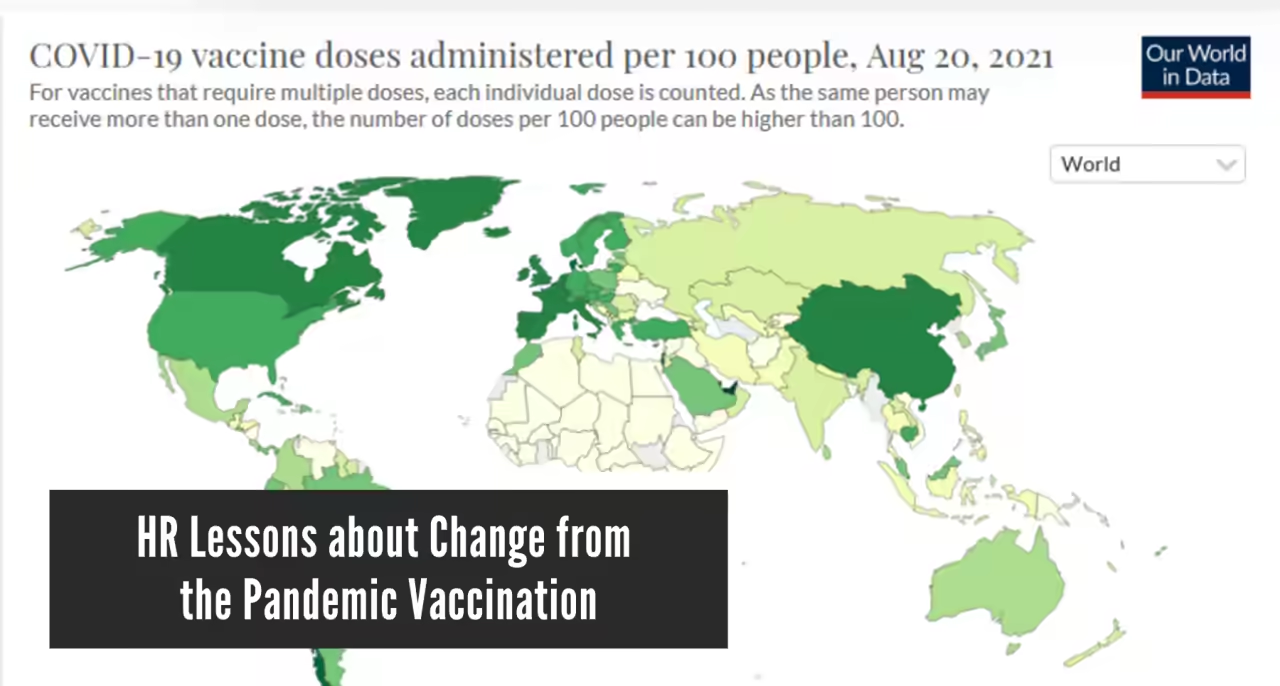The COVID pandemic has been a source of leadership and HR lessons for the last 18 months with insights on:
- Leaders as mystery explorers, anthropologists, and creators of emotional well-being.
- The redefinition of work to deal with hybrid organizations, work boundaries, emerging organization capabilities (e.g., agility, social responsibility, purpose), and harnessing uncertainty.
- Emerging employee experience with personalization (belief, become, and belong) and digital redefinition of where and how work is done.
- HR contributions through human capability (talent, leadership, and organization) that deliver stakeholder outcomes.
As vaccines become prevalent, the process of administering the vaccine can be compared with any change agenda to provide insights about how to manage change.
The scientific evidence is that vaccines help prevent COVID infection, make it less damaging if infected, and that the benefits of vaccination far outweigh the risks.
Given the evidence concerning its efficacy and the progress made against the pandemic, why are (in the United States) only about 50 to 60 percent of those eligible vaccinated? (see global map)
More broadly, for any change agenda with likely positive outcomes, why is buy-in and commitment so difficult? What can be learned and adapted from the analysis of the vaccination process?
1. Set realistic goals.
Buy-in to any change agenda does not have to reach 100 percent to be effective (e.g., elections are won by 51 percent of the vote in the United States). For COVID-19, herd immunity (when the disease no longer poses an epidemic or pandemic threat) occurs with 70 to 80 percent immunity through vaccine or antibodies. This means that a successful vaccination rate would be 80 percent, enough to mitigate the risks of the virus. Looking at another example, few would question if seat belts save lives, and in the United States, seat belt use has gone from about 14 percent in 1983 to about 85 to 90 percent in 2018. Note that 10 to 15 percent still do not wear seat belts, but most do.
Change lesson 1: Have we set realistic (critical mass) buy-in goals for our change agenda?
2. Ignore the adamant naysayers.
With 80 percent as the threshold, acknowledge that naysayers are inevitable—or those who adamantly oppose any agenda. This is a group of individuals who, for whatever reason, will not likely ever engage in the new behavior. Spending leadership attention trying to convince them to do so is not helpful because their joining the change effort is generally not necessary to move ahead (e.g., herd immunity), and the adamant naysayers simply cannot be convinced. Related to the vaccination situation, given the current vaccination rates, the US goal would be to go from the current 50 percent to 80 percent vaccination (an increase of 30 percent). At times is a social media/digital world, this 15% sounds as if they are more; it is important to remember the actual percent and respond accordingly. While not being distracted by the adamant naysayers, identify change champions or individuals who will act as ambassadors of the message and carry it to others.
Change lesson 2: Identify the adamant naysayers and respect them, but don’t spend time trying to convince them.
3. Explore reasons why people resist the change.
In any change, resistance comes in many forms. Understanding these reasons for resistance allows for tailored solutions. Again, those labeled resistors may not agree with the change but are open to changing their mind. In cognitive psychology, mindsets can be changed with information (know why something matters), behavior (behave as if something matters), and reinforcement (incentives that encourage what matters). When people who may initially resist but are open to change feel understood, they are more likely to engage in the desired change (see work on motivational interviewing). Looking at COVID-19 vaccines as an example, for those not vaccinated, the reasons (and solutions) might include:
Change lesson 3: Listen, understand, and persuade in ways personalized to an individual’s resistance.
4. Share the process of decision-making as much as or more than the outcome of the decision
When people understand the why, they are more likely to accept the what. Explaining why a particular policy is in place increases commitment to the change. Managing the process of change also includes involving others in setting goals, adapting to circumstances, learning from experiments, and sharing results. Engaging others in the solution helps them behave as if they are committed. In the vaccine case, some industries and organizations are more affected by lack of employee vaccination than others. Travel, health care, hospitality, services, leisure, education, and other face-to-face industries are more affected by COVID risks. Leaders in these organizations can be very clear about the economic and social costs of not being vaccinated to all employees, even to the point of requiring vaccination for employment.
Change lesson 4: Manage the process of sharing information and engaging others in the behaviors of the change.
5. Reinforce the desired behavior
Positive reinforcement may come from financial (e.g., incentives to get the vaccine) or non-financial (e.g., celebrate and acknowledge those who have received the vaccine). Reinforcement also comes from weaving the activity into ongoing HR practices such as staffing, training, promotion, compensation, and communications.
Change lesson 5: Celebrate success through stories and ensure sustained progress by weaving change into organization routines.
6. Add your own
Summary: Inevitably, in any change process, some are early adopters who readily engage in the desired behavior, and others are adamant naysayers who will never change. When leaders focus on the majority between these two extremes and use the five change lessons, they will be able to reach critical mass to move change forward.



